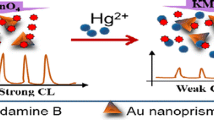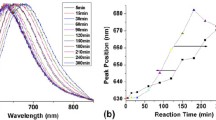Abstract
Monodisperse and “naked” gold nanoparticles (GNPs) were modified with thioglycolic acid (TGA). The fluorescence of rhodamine B (RB) is quenched completely by the gold NPs surface with negative charge mainly as a result of fluorescence resonance energy transition (FRET) and collision. The quenching mechanism can be described by a Langmuir isotherm, which was systematically investigated by steady-state fluorescence spectrometry and absorption spectrometry. Hg(II) ion disrupts the GNPs–RB pair, producing a large “switch-on” fluorescence. A low background, highly sensitive and reproducible fluorescence assay for Hg(II) is presented. Under the optimum conditions, the restoration fluorescence intensity is proportional to the concentration of Hg(II). The calibration graphs are linear over the range of 1.0 × 10−9 to 3.1 × 10−8 mol L−1 with a detection limit of 4.0 × 10−10 mol L−1. The relative standard deviation was 1.2% for a 5.0 × 10−9 mol L−1 Hg(II) solution (N = 6). This method was applied to the analysis of Hg(II) in environmental water samples, and the results were consistent with those of atomic absorption spectroscopy (AAS).







Similar content being viewed by others
References
de Silva AP, Gunarane HQN, Gunnlaugsson TA, Huxley JM, McCoy CP, Rademacher JT, Rice TE (1997) Signaling recognition events with fluorescent sensors and switches. Chem Rev 97:1515
Fabbrizzi L, Poggi A (1995) Sensors and switches from supramolecular chemistry. Chem Soc Rev 24:197
Zheng W, Aschner M, Ghersi-Egea JF (2003) Brain barrier systems: a new frontier in metal neurotoxicological research. Toxicol Appl Pharmacol 192:1
Vil’pan YA, Grinshtein IL, Akatove AA, Gucer S (2005) Direct atomic absorption determination of mercury in drinking water and urine using a two-step electrothermal atomizer. J Anal Chem 60:38
Karunasagar D, Arunachalam J, Gangadharan S (1998) Development of a collect and punch cold vapour inductively coupled plasma mass spectrometric method for the direct determination of mercury at nanograms per litre levels. J Anal At Spectrom 13:679
Yu LP, Yan XP (2004) Flow injection online sorption preconcentration coupled with cold vapor atomic fluorescence spectrometry with online oxidative elution for determination of trace mercury in water samples. At Spectr 25:145
Trimble CA, Hoenstine RW, Highley AB, Donoghue JF, Ragland PC (1999) Baseline sediment trace metals investigation: steinhatchee river estuary, Florida, Northeast Gulf of Mexico. Mar Georesour Geotechnol 17:187
Yin X, Xu Q, Xu X (1995) Speciation analysis of mercury I. Separation and determination of methylmercury, ethylmercury, phenylmercury and mercury (II) by liquid chromatography after chloroform extraction. Fenxi Huaxue 23:1168
Fan LJ, Zhang Y, Jones WE (2005) Design and synthesis of fluorescence “turn-on” chemosensors based on photoinduced electron transfer in conjugated polymers. Macromolecules 38:2844
Kim IB, Bunz UHF (2006) Modulating the sensory response of a conjugated polymer by proteins: an agglutination assay for mercury ions in water. J Am Chem Soc 128:2818
Zhao Y, Zhong Z (2006) Tuning the sensitivity of a foldamer-based mercury sensor by its folding energy. J Am Chem Soc 128:9988
Cheng P, He C (2004) A general strategy to convert the MerR family proteins into highly sensitive and selective fluorescent biosensors for metal ions. J Am Chem Soc 126:728
Ono A, Togashi H (2004) Highly selective oligonucleotide-based sensor for mercury(II) in aqueous solutions. Angew Chem Int Ed 43:4300
Matsuchita M, Meijler MM, Wirsching P, Lerner RA, Janda KD (2005) A blue fluorescent antibody-cofactor sensor for mercury. Org Lett 7:4943
Chen JL, Gao YC, Xu ZB, Wu GH, Chen YC, Zhu CQ (2006) A novel fluorescent array for mercury (II) ion in aqueous solution with functionalized cadmium selenide nanoclusters. Anal Chim Acta 577:77
Zhu CQ, Li L, Fang F, Chen JL, Wu YQ (2005) Functional InP nanocrystals as novel near-infrared fluorescent sensors for mercury ions. Chem Lett 34:898
Cai ZX, Yang H, Zhang Y, Yan XP (2006) Preparation, characterization and evaluation of water-soluble l-cysteine-capped-CdS nanoparticles as fluorescence probe for detection of Hg(II) in aqueous solution. Anal Chim Acta 559:234
Liu B, Tian H (2005) A selective fluorescent ratiometric chemodosimeter for mercury ion. Chem Commun 25:3156–3158
Yang YK, Yook KY, Tae JS (2005) A rhodamine-based fluorescent and colorimetric chemodosimeter for the rapid detection of Hg2+ ions in aqueous media. J Am Chem Soc 127:16760
Zheng H, Qian ZH, Xu L, Yuan FF, Lan LD, Xu JG (2006) Switching the recognition preference of rhodamine B spirolactam by replacing one atom: design of rhodamine B thiohydrazide for recognition of Hg(II) in aqueous solution. Org Lett 8:859
Kim SH, Kim JS, Park SM, Chang SK (2006) Hg2+-selective off–on and Cu2+-selective on–off type fluoroionophore based upon cyclam. Org Lett 8:371
Lee MH, Wu JS, Lee JW, Jung JH, Kim JS (2007) Highly sensitive and selective chemosensor for Hg2+ based on the rhodamine fluorophore. Org Lett 9:2501
Nolan EM, Lippard SJ (2007) Turn-on and ratiometric mercury sensing in water with a red-emitting probe. J Am Chem Soc 129:5910
Hu M, Chen JY, Li ZY, Au L, Hartland GV, Li XD, Marquez M, Xia YN (2006) Gold nanostructures: engineering their plasmonic properties for biomedical applications. Chem Soc Rev 35:1084
Bukasov R, Shumaker-Parry JS (2007) Highly tunable infrared extinction properties of gold nanocrescents. Nano Lett 7:1113
Liu JW, Lu Y (2005) Stimuli-responsive disassembly of nanoparticle aggregates for light-up colorimetric sensing. J Am Chem Soc 127:12677
Norsten TB, Frankamp BL, Rotello VM (2002) Metal directed assembly of terpyridine-functionalized gold nanoparticles. Nano Lett 2:1345
Obare SO, Hollowell RE, Murphy CJ (2002) Sensing strategy for lithium ion based on gold nanoparticles. Langmuir 18:10407
Lin SY, Chen CH, Lin MC, Hsu HF (2005) A cooperative effect of bifunctionalized nanoparticles on recognition: sensing alkali ions by crown and carboxylate moieties in aqueous media. Anal Chem 77:4821
Choi YD, Ho NH, Tung CH (2007) Sensing phosphatase activity by using gold nanoparticles. Angew Chem Int Ed 46:707
Lin SY, Wu SH, Chen CH (2006) A simple strategy for prompt visual sensing by gold nanoparticles: general applications of interparticle hydrogen bonds. Angew Chem Int Ed 45:4948
Kim YJ, Johnson RC, Hupp JT (2001) Gold nanoparticle-based sensing of “spectroscopically silent” heavy metal ions. Nano Lett 1:165
Rex M, Hernandez FE, Campiglia AD (2006) Pushing the limits of mercury sensors with gold nanorods. Anal Chem 78:445
Huang CC, Chang HT (2007) Parameters for selective colorimetric sensing of mercury(II) in aqueous solutions using mercaptopropionic acid-modified gold nanoparticles. Chem Commun 12:1215–1217
Lee JS, Han MS, Mirkin CA (2007) Colorimetric detection of mercuric ion (Hg2+) in aqueous media using DNA-functionalized gold nanoparticles. Angew Chem Int Ed 46:4093
Kamat PV, Barazzouk S, Hotchandani S (2002) Electrochemical modulation of fluorophore emission on a nanostructured gold Film. Angew Chem Int Ed 41:2764
Dulkeith E, Morteani AC, Niedereichholz T, Klar TA, Feldmann J, Levi SA, van Veggel FCJM, Reinhoudl DN, Möller M, Gittins DI (2002) Fluorescence quenching of dye molecules near gold nanoparticles: radiative and nonradiative effects. Phys Rev Lett 89:203002
Huang T, Murray RW (2002) Quenching of [Ru(bpy)3]2+ fluorescence by binding to Au nanoparticles. Langmuir 18:7077
Clapp AR, Medintz IL, Mauro JM, Fisher BR, Bawendi MG, Mattoussi H (2004) Fluorescence resonance energy transfer between quantum dot donors and dye-labeled protein acceptors. J Am Chem Soc 126:301
Oh E, Hong MY, Lee D, Nam SH, Yoon HC, Kim HS (2005) Inhibition assay of biomolecules based on fluorescence resonance energy transfer (FRET) between quantum dots and gold nanoparticles. J Am Chem Soc 127:3270
Oh E, Lee DH, Kim YP, Youp S, Oh DB, Kang HA, Kim JB, Kim HS (2006) Nanoparticle-based energy transfer for rapid and simple detection of protein glycosylation. Angew Chem Int Ed 45:7959
Wang LY, Yan RX, Huo ZY, Wang L, Zeng JH, Bao J, Wang X, Peng Q, Li YD (2005) Fluorescence resonant energy transfer biosensor based on upconversion-luminescent nanoparticles. Angew Chem Int Ed 44:6054
Fisher NO, McIntosh CM, Simard JM, Rotello VM (2002) Supramolecular chemistry and self-assembly special feature: inhibition of chymotrypsin through surface binding using nanoparticle-based receptors. Proc Natl Acad Sci 99:5018
You CC, Miranda OR, Gider B, Ghoshi PS, Kim IB, Erdogan B, Krovi SA, Bunz UHF, Rotello VM (2007) Detection and identification of proteins using nanoparticle-fluorescent polymer ‘chemical nose’ sensors. Nat Nanotech 2:318
He XR, Liu HB, Li YL, Wang S, Li YJ, Wang N, Xiao JC, Xu XH, Zhu DB (2005) Gold nanoparticle-based fluorometric and colorimetric sensing of copper (II) ions. Adv Mater 17:2811
Huang CC, Chang HT (2006) Selective gold-nanoparticle-based “Turn-On” fluorescent sensors for detection of mercury (II) in aqueous solution. Anal Chem 78:8332
Chen JL, Zheng AF, Chen AH, Gao YC, He CY, Kai XM, Wu GH, Chen YC (2007) A functionalized gold nanoparticles and rhodamine 6G based fluorescent sensor for high sensitive and selective detection of mercury (II) in environmental water samples. Anal Chim Acta 599:134
Mucic RC, Storhoff JJ, Mirkin CA, Letsinger RL (1998) DNA-directed synthesis of binary nanoparticle network materials. J Am Chem Soc 120:12674
Grabar KC, Freeman RG, Hommer MB, Natan MJ (1995) Preparation and characterization of Au colloid monolayers. Anal Chem 67:735
Morris T, Copeland H, McLinden E, Wilson S, Szulczewski G (2002) The effects of mercury adsorption on the optical response of size-selected gold and silver nanoparticles. Langmuir 18:7261
Henglein A, Giesig M (2000) Optical and chemical observations on gold–mercury nanoparticles in aqueous solution. J Phys Chem B 104:5056
Vedrina-Dragojevič I, Dragojević D, Čadež S (1997) Spectrofluorimetric method for the determination of the total mercury content in sediment and soil. Anal Chim Acta 355:151
Balint L, Vedrina-Dragojević I, Šebečić B, Momirović-Čuljat J, Horvatić M (1997) Spectrofluorometric method for determination of the total mercury content in environmental samples-waste waters. Microchim Acta 127:61
Sudeep PK, Shidu Joseph ST, Thomas KG (2005) Selective detection of cysteine and glutathione using gold nanorods. J Am Chem Soc 127:6516
Kou XS, Zhang SZ, Yang Z, Tsung CK, Stucky GD, Sun LD, Wang JF, Yan CH (2007) Glutathione- and cysteine-induced transverse overgrowth on gold nanorods. J Am Chem Soc 129:6402
Lim IS, Goroleski F, Mott D, Karriuki N, Ip W, Luo J, Zhong CJ (2006) Adsorption of cyanine dyes on gold nanoparticles and formation of J-aggregates in the nanoparticle assembly. J Phys Chem B 110:6673
Barazzouk S, Kammat PV, Hotchandani S (2005) Photoinduced electron transfer between chlorophyll a and gold nanoparticles. J Phys Chem B 109:716
Nasr C, Liu D, Hotchandani S, Kammat PV (1996) Dye capped semiconductor colloids. Excited state and photosensitization aspects of Rhodamine 6G-H aggregates electrostatically bound to SiO2 and SnO2 Colloids. J Phys Chem B 100:11054
Chandrasekharan N, Kammat PV, Hu JQ, Jones G II (2000) Dye-capped gold nanoclusters: photoinduced morphological changes in gold/rhodamine 6G nanoassemblies. J Phys Chem B 104:11103
Fan CH, Wang S, Hong JW, Bazan GC, Plaxco KW, Heeger AJ (2003) Beyond superquenching: Hyper-efficient energy transfer from conjugated polymers to gold nanoparticles. Proc Natl Acad Sci 100:6297
Chen JS, Chang HT (2004) Nile Red-adsorbed gold nanoparticles for selective determination of thiols based on energy transfer and aggregation. Anal Chem 76:3727
According to the EPA guidelines (http://oaspub.epa.gov), tolerance limit for merury in drinking water is no greater than 0.002 mg l−1
Iandor MS, Geistmann F, Schuster M (1999) An anthracene-substituted benzoylthiourea for the selective determination of Hg(II) in micellar media. Anal Chim Acta 388:19
Lista AG, Palomeque ME, Fernández Band BS (1999) Flow-injection fluorimetric determination of mercury (II) with calcein. Talanta 50:881
Juskowiak B (1996) Efficient quenching of the fluorescence of binaphthyl-based amphiphiles by mercury (II) complexes. Anal Chim Acta 320:115
Hosseini MS, Hashemi MH (2004) Flotation-spectrophotometric determination of mercury in water samples using iodide and ferroin. Anal Sci 20:1449
Acknowledgments
The authors acknowledge the support from the Education Commission Natural Science Foundation of Anhui Province (2006kj153B, 2006jql204).
Author information
Authors and Affiliations
Corresponding author
Electronic supplementary material
Below is the link to the electronic supplementary material.
Rights and permissions
About this article
Cite this article
Zheng, A., Chen, J., Wu, G. et al. Optimization of a sensitive method for the “switch-on” determination of mercury(II) in waters using Rhodamine B capped gold nanoparticles as a fluorescence sensor. Microchim Acta 164, 17–27 (2009). https://doi.org/10.1007/s00604-008-0023-4
Received:
Accepted:
Published:
Issue Date:
DOI: https://doi.org/10.1007/s00604-008-0023-4




